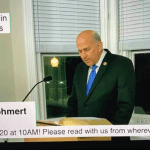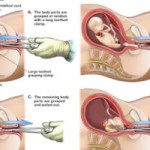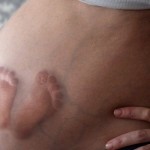Federal judge William S. Stickman recently ruled that Pennsylvania Governor Tom Wolf’s orders and ongoing directives to keep businesses closed and the state shut down due to minimizing the spread of the coronavirus, is unconstitutional.
Stickman ruled that both the governor and the state health department’s secretary, Dr. Rachel Levine, “crossed the lines” established by the U.S. Constitution. Stickman ruled that limits on gatherings issued by the Wolf administration violated the First Amendment right of assembly. The stay at home orders and business closures the governor imposed during the early days of the coronavirus outbreak violated the Due Process and Equal Protection clauses of the Fourteenth Amendment of the U.S. Constitution, the judge also ruled.
Among the plaintiffs in the case were several counties, a number of businesses, and individuals, including U.S. Rep. Mike Kelly and state Reps. Daryl Metcalfe, Marci Mustello, and Tim Bonner.
The ruling accomplished what state legislators had failed to accomplish after introducing numerous bills to curtail the governor’s power, only to be vetoed after both houses passed the bills.
Last month, the American Pastors Network and Pennsylvania Pastors Network sent an Open Letter to all three branches of state government, with an accompanying resolution. The resolution lists examples of “gubernatorial malfeasance and violations of authority to which the Pennsylvania Supreme Court enjoined.” It also lists examples of personal harm allegedly caused or created by various policy decisions imposed by the governor and state department of health secretary.
The open letter states, in part,
“The harmful impact of COVID-19 public policies on our families and children, churches and schools, businesses and the economy is almost beyond measure. Sweeping and unilateral orders emanating from state and federal Executive Branches have wearied the citizens of this nation and of the Commonwealth of Pennsylvania. Yet, while most citizens have patiently endured the restrictions on our freedoms of assembly, worship, travel, education and work, that time has ended.
“When a former Pennsylvania General Assembly extended limited authority to future Governors as head of the Executive Branch to temporarily suspend certain statutory laws in case of a clear “Natural Disaster,” there was no anticipation that this privilege would be so abused with the limited “temporary” authority arrogantly extended into a more “permanent” authority remaking the entire system of representative government.”
Former state legislator and president of APN, Sam Rohrer, called on pastors to lead the citizens of Pennsylvania in their shared responsibility to “Restore the Law.”
“Judge Stickman’s decision gives overwhelming support to the Legislature, but it does not re-establish the Legislature’s constitutional authority usurped by our Pennsylvania Supreme Court and the Wolf led Executive Branch,” Rohrer said. “The judge’s decision confirms the identification of the problem as lawlessness and by extension the resultant serious unbalancing of the delicate Balance of Power in our Commonwealth – the same as we are seeing all across America.”
“No citizen though, nor judicial branch action can re-establish the constitutional balance of power or restore the law,” the Pastor’s Council argues, which is why it has called on the state legislature to act once again. Even if that means the legislature comes together to overrule another one of the governor’s vetoes.
Within one day of the ruling, Wolf said, “… the vast majority simply don’t buy into the conspiracy theories or fear mongering from the president or from the Harrisburg Republicans about this virus.”
His attorneys are preparing an appeal, NBC News 10 Philadelphia reported.
“Judge Stickman’s opinion confirms what Pennsylvania Republicans have been saying all along: The Wolf administration’s use of emergency authority is unconstitutionally overbroad,” House Speaker Bryan Cutler, R-Lancaster, and House Majority Leader Kerry Benninghoff, R-Centre, said in a written statement.
According to the state’s coronavirus database, more people have tested negative than positive for the coronavirus in Pennsylvania. Coronavirus-related deaths represent .016 percent of the state’s more than 12.8 million population.
As of September 15, there are 141,950 confirmed positive coronavirus cases, 1,695,284 confirmed negative tests, and 7,875 coronavirus-related deaths.
The databased does not publish false positive data or recovery data. Nor does it distinguish between a death caused solely “from” the coronavirus or one categorized “with the virus.” One who dies with comorbidity factors, while also having tested positive for the virus, is counted as a coronavirus death.
According to the state’s database, 7,875 deaths out of 141,950 positive cases represents a 94.5 percent recovery rate.
A recent Centers for Disease Control (CDC) report found that only 6 percent of deaths reported by state health departments were directly caused by the coronavirus.
The overwhelming majority of reported coronavirus-related deaths in the U.S. – 94 percent – involved patients who had at least one other underlying health condition, such as a respiratory illness, diabetes, heart disease or another, the CDC says, known as comorbity.
Comorbidity data is also excluded from Pennsylvania’s public database.
“COVID-19 was the only cause mentioned” for 6 percent of the coronavirus deaths reported to the CDC, according to its weekly index based on death certificate data received and coded by the National Center for Health Statistics as of Aug. 26, 2020.
Of the 94 percent who died with COVID-19 and other ailments, there were, on average, “2.6 additional conditions or causes per death.”
Pennsylvania has not published in its database which of the comorbidity factors its 7,875 residents died “from” or “with,” in addition to also having tested positive from the coronavirus.
Comorbidity factors include “more than one disease or condition is present in the same person at the same time,” or “chronic or long-term conditions,” or “coexisting or co-occurring conditions.” They are also referred to as “multimorbidity” or “multiple chronic conditions.”
These conditions include influenza and pneumonia, respiratory failure, hypertensive disease, diabetes, vascular and unspecified dementia, cardiac arrest, heart failure, renal failure, intentional and unintentional injury, poisoning and other adverse events, and other medical conditions.
Even including the comorbidity factors of coronavirus-related deaths, as a percentage of the state’s more than 12.8 million population, deaths the state has attributed to COVID-19 account for .016 percent. This number would be significantly lower if comorbidity data were reported.
Due to the state’s ongoing shutdown resulting from the governor’s executive orders, the unemployment rate in July was 13.7 percent, up from 4.4 percent in July 2019. More than three times the number of people were put out of work this year by an executive order over a virus that has at least a 95 percent survival rate and whose deaths, as a percentage of the population, account for .016 percent.











